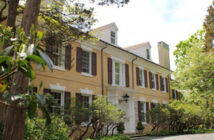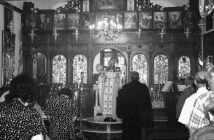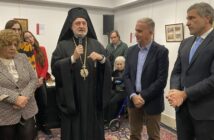St. Nicholas Greek Orthodox Church Designed by Santiago Calatrava
Source: The Wall Street Journal
By RALPH GARDNER JR.
Renderings of the new St. Nicholas Greek Orthodox Church designed by Santiago Calatrava, which will overlook the 9/11 Memorial, in a video provided by his architecture firm. Photo: Santiago Calatrava
It took two hours of talking with architect Santiago Calatrava —we touched on rock climbing, the Swiss cheese dish raclette, Rembrandt’s self-portraits and New York City’s tradition of great civic architecture—before I realized how appropriate the placement is of St. Nicholas Greek Orthodox Church, which will overlook the 9/11 Memorial.
And not just because it’s the rebirth of the church, a fixture in the neighborhood since the 19th century until it was destroyed by the collapse of the World Trade Center’s south tower on Sept. 11, 2001.
Mr. Calatrava designed the church and will attend its groundbreaking on Saturday. If everything goes according to schedule, the building should be finished in 2016 or early 2017.
While the 9/11 Memorial, with its twin reflecting pools and alleys of trees, masterfully creates an opportunity for quiet reflection, there’s also something to be said for a sanctuary with four walls—and perhaps for lighting a memorial candle, no matter what religion you practice, or even if you practice no religion at all.
“All the circumstances around 9/11, the memorial embodies that very well,” Mr. Calatrava said as he sat in the stately Park Avenue townhouse that does double duty as his home and his office.
Then, the architect pulled out the sketches that won him the competition to rebuild St. Nicholas, describing the church with words such as “full” and “introverted” to illustrate how different the experience will be from the voids of the reflecting pools.
Unlike what you might expect, the renderings aren’t architecturally rigorous. They are relatively simple, rather impressionistic drawings—of a mosaic of the Madonna and Child Enthroned at the Hagia Sophia in Istanbul that morph into a church with a cupola, of flowers and domes produced during a visit to Mount Athos in Greece.
My hunch is that many architects don’t operate that way.
“In Europe, I dedicate the morning until noon,” to drawing, said Mr. Calatrava, who divides his time between New York and another home and office in Zurich. “And in America I do it mostly in the afternoon to the evening.”
Born in Spain, the 63-year-old Mr. Calatrava isn’t only an architect. He also paints, sculpts and designs furniture.
“I started in an art school,” he added. “I have always been working in art. I do that mostly alone with very little assistance.”
While acknowledging that architecture is among the most collaborative of professions, he said, “It’s also a very meditative job. It’s important to travel into yourself.”
That might explain why he’s producing some of the most innovative and controversial architecture today—controversial as much for cost overruns and feasibility as for design.
Among his creations is the bird-winged PATH station at the World Trade Center, scheduled to be completed next year at almost $4 billion—double the projected cost.
We didn’t much delve into the controversy. The architect did mention that train stations are challenging—because the trains have to keep running—but that he has completed seven of them.
Mr. Calatrava, his wife, Robertina, and their four children moved to the U.S. only a couple of months after 9/11. But his relationship with the city started well before that.
His first visit occurred in the mid-70s when he traveled the country on a Greyhound bus and remembers his first encounter with Grand Central Terminal—and with the law.
“I stay there watching the whole experience,” he recalled. “I was in ecstasy. After 15 minutes a policeman came and said, ‘What are you doing?’ I was the only one not moving.”
He noted New York’s tradition of great architecture, including the Brooklyn Bridge and the Seagram Building.
“New York is a good school of these kinds of spaces. I say many times I came to learn from New York.”
He hopes the World Trade Center PATH station will be uttered in the same breath as those other architectural wonders.
“I like when a building tells you a story,” he said.
However, the architect pointed out that his contribution to the narrative of the Church of St. Nicholas is circumscribed by a thousand years of tradition.
“It’s like climbing a rock,” he said of a sport he gave up, though he remains an enthusiastic hiker in the Alps. “You don’t have a grip. You only have some millimeters.”
Still, a video of the yet-to-be-built church, made of white Vermont marble and with spaces that filter light inside during the day and make the structure glow at night, makes it clear his contribution is far from negligible.
“This is what I want; this is what the church wants: a very ecumenical place; they would like to have 24 hours the church open.”
But Mr. Calatrava conceded the public has the last word.
“When it’s finished,” he said, “we’ll go there and ask what the building is telling us.”
[subscribe2]


